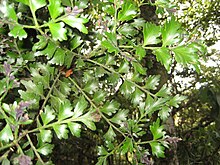Phyllocladus trichomanoides
| Tanekaha | |
|---|---|

| |
| Scientific classification | |
| Kingdom: | Plantae |
| Clade: | Tracheophytes |
| Clade: | Gymnospermae |
| Division: | Pinophyta |
| Class: | Pinopsida |
| Order: | Araucariales |
| Family: | Podocarpaceae |
| Genus: | Phyllocladus |
| Species: | P. trichomanoides
|
| Binomial name | |
| Phyllocladus trichomanoides D.Don
| |
Phyllocladus trichomanoides, the tanekaha, is a coniferous tree native to New Zealand.
Tanekaha is a medium-sized forest tree growing up to 20 m in height and 1 m trunk diameter. The main structural shoots are green for 2–3 years, then turn brown as the bark thickens. The leaves are sparse, tiny, scale-like, 2–3 mm long, and only green (photosynthetic) for a short time, soon turning brown.
Most photosynthesis is performed by highly modified, leaf-like short shoots called phylloclades; these are arranged alternately, 10-15 on a shoot, the individual phylloclades rhombic, 1.5-2.5 cm long. The seed cones are berry-like, with a fleshy white aril surrounding but not fully enclosing the single seed.
Economic uses
Like the kauri, tanekaha shed their lower branches, producing smooth straight trunks and knot-free timber which is sought after for its strength.
The bark is rich in tannin, from which Māori extracted a red dye.

